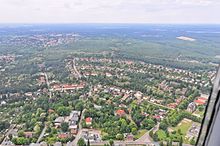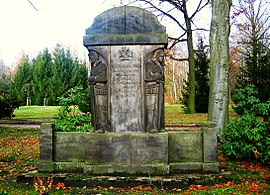Peace Memorial Church (Lauchhammer)
The Friedensgedächtniskirche is a listed building in Lauchhammer-Ost , a district of the town of Lauchhammer in the Oberspreewald-Lausitz district in southern Brandenburg, and is registered in the Brandenburg List of Monuments .
The church, which was built in 1917 and 1918 as a "Peace Memorial Church", was consecrated on November 18, 1917. The building, originally built as a factory church and memorial, was converted into a conference and event location after the fall of the Wall and is now under the Motto “Experience culture” is the cultural center of the district and the city of Lauchhammer. In addition to being used for small theaters, cabaret and film screenings, the church can also be used for weddings, among other things.
Building description and history
prehistory
The Lauchhammeran district of Lauchhammer-Ost was created in 1929 by amalgamating the village of Naundorf, which was first mentioned in 1418, and the disbanded manor district of Lauchhammer . The new community was named Lauchhammer , which was also taken over in 1953 by the town of Lauchhammer , which emerged from the larger community of Lauchhammer .
The settlement area around Naundorf and Lauchhammer originally belonged to the old parish of Bockwitz (today Lauchhammer-Mitte). In 1874 a bell tower was built next to the local school to hang a bell that was given that same year. With the arrival of industrialization in the village, which began early with the establishment of the Lauchhammer in 1725 by Baroness Benedicta Margareta von Löwendal , the population of the small community grew steadily. Around 1820, 130 inhabitants were given here for Naundorf . Around 1890 there are 530. With the discovery and extraction of the local lignite deposits, the population then grew explosively , as in all places in the Mückenberger Ländchen , to 4088 inhabitants in Naundorf and the immediately neighboring estate district around 1925.
A local church became necessary. The project came into the focus of Lauchhammer AG, which was based here and was enjoying an economic boom at the time . She finally tackled the project, which at that time was considered unique in Germany. A factory church was built for the Lauchhammerwerk.
The Friedensgedächtniskirche as a factory church and memorial
The Peace Memorial Church, which was built in a park-like complex, is a rectangular and plastered hall building with a hipped roof and dormers . In the east of the nave there is a 24 meter high church tower with a mansard tent roof . A tower clock was installed below the bell storey . In terms of architectural style, the building is classified as "neo-Romanesque-neo-baroque". The building located on a hill can be reached via a wide flight of stairs, which is brought up to the building on the east side.
The flat-roofed interior of the church has been preserved in its original state from the floor plan to the present day. On the sides of the vestibule located under the tower, there is a staircase and another small hall that is currently used as an event room. A round-arched triumphal arch leads to the sanctuary to the west of the nave. A small sacristy is located next to the chancel .
The church was built in 1916 and 1917 as a factory church for the Lauchhammerwerk. The foundation stone was laid on August 28, 1916. A certain Mr. Tafel was responsible as the master builder, and Lauchhammer AG was the client . The church was consecrated on November 18, 1917. Its name Friedensgedächtniskirche comes from the end of the First World War ; it served as a memorial and memorial for the fallen workers., and was furnished accordingly. Constantin von Mitschke-Collande (1912–1983), from Dresden-Laubegast, painted the church. The baptismal font and the altar of the church were made of marble . On the walls of the building there were iron plaques with the names of the fallen. The organ on the east gallery was built by the Dresden organ builder, Gebrüder Jehmlich . The three cast steel bells - a gift from General Director Wiecke - came from a foundry in Bochum ; the bell foundry in the neighboring ironworks was not set up until a few years later.
After the National Socialists came to power in 1933, parts of the original painting disappeared. Since works by the artist Constantin von Mitschke-Collande were denounced as “ degenerate art ” in 1937 , the two round windows with stars of David in the chancel were walled up.
The church in GDR times

After the end of the Second World War , Lauchhammer AG was expropriated and the Friedensgedächtniskirche became community property. In Lauchhammer-Ost the establishment of its own pastor's office took place in 1951 and a year earlier Lauchhammer had already become part of the new large municipality of Lauchhammer , which finally received town charter in 1953 , which the district of Mückenberg (today Lauchhammer-West ) had a few centuries before it was incorporated held.
In the course of an extensive interior renovation, the chancel was given a three-meter-high window, the stained glass of which was designed by the Dresden painter Rudolf Nehmer (1912–1983). In addition, the marble altar and the urn-shaped baptism have disappeared; their whereabouts are unclear. They were replaced from wood and this time designed together with the pulpit by the Magdeburg wood sculptor Ludwig Göbel . The memorial plaques on the walls of the church have also been removed. They stood in the way of the newly installed lighting.
A memorial for the fallen of the two world wars can still be found on the grounds of the Lauchhammer-Ost cemetery.
- Memorial to the fallen at the Lauchhammer-Ost cemetery
Use as a public meeting and event location
The building was used for church until shortly after the fall of the Wall . Lack of financial means threatened to decay and the Protestant church gave up the use of the church. In 1999 the parish of Lauchhammer East-South-West was finally established.
With the help of the agency for work , donations and own funds of Wequa, the Peace Memorial Church was renovated and converted into a conference and event location, which is the property of the city of Lauchhammer. Since August 1999 it has been operated as part of the “House of Opportunities” project by the Lauchhammer Business Development and Qualification Ltd ( WEQUA for short ). The interior walls of the nave were hung with curtains.
Since then, the church has been an important part of the city's cultural infrastructure. Numerous artists, politicians and other public figures performed here. In addition to being used for small theaters , cabaret and film screenings, the church can also be used for weddings. The traditional devotions before each bell casting in the neighboring Lauchhammer bell foundry take place here.
The Jehmlich organ from 1920 was cleaned and partially restored in 2004 with the help of donations from the Bad Liebenwerda organ building company Voigt . It has 866 pipes, two manuals and a pedal and is used sporadically for concerts.
In 2015 the dormer windows were renovated.
Regular events in the Friedensgedächtniskirche (selection)
- Annual Barbara celebration of the traditional Lauchhammer club
Literature (selection)
- Bernd Engelmann: Peace Memorial Church . In: Home calendar for the Bad Liebenwerda district and the Mückenberger Ländchen . 1996, p. 159 to 162 .
Web links
- Entry in the monument database of the State of Brandenburg
- Internet presence of the Friedensgedächtniskirche
- The Friedensgedächtniskirch on the municipal website of Lauchhammer
- Chronicle of the Peace Memorial Church on the WEQUA website
Notes and individual references
- ↑ Database of the Brandenburg State Office for the Preservation of Monuments and the State Archaeological Museum ( Memento of the original from December 9, 2017 in the Internet Archive ) Info: The archive link has been inserted automatically and has not yet been checked. Please check the original and archive link according to the instructions and then remove this notice. , accessed November 6, 2017.
- ^ The Peace Memorial Church on the Lauchhammer homepage. Retrieved August 14, 2009 .
- ↑ a b c d Luise Grundmann, Dietrich Hanspach (author): Der Schraden. A regional study in the Elsterwerda, Lauchhammer, Hirschfeld and Ortrand area . Ed .: Institute for Regional Geography Leipzig and the Saxon Academy of Sciences in Leipzig. Böhlau Verlag, Cologne, Weimar, Vienna 2005, ISBN 3-412-10900-2 , pp. 157-161 .
- ↑ Berndt Engelmann: "The Peace Memorial Church in Lauchhammer-Ost" In: Local calendar for the old district of Bad Liebenwerda, the Mückenberger Ländchen, outskirts on Schraden and Uebigau-Falkenberg . Ed .: Arbeitsgemeinschaft für Heimatkunde e. V. Bad Liebenwerda. Bad Liebenwerda 1996, p. 159-162 .
- ↑ Historical municipality directory of the State of Brandenburg (online as PDF file)
- ↑ a b c d e f g h i j Bernd Engelmann: Friedens-Gedächtnis-Kirche . In: Home calendar for the Bad Liebenwerda district and the Mückenberger Ländchen . 1996, p. 159 to 162 .
- ^ Georg Dehio : Handbook of German Art Monuments - Brandenburg . 2nd Edition. 2012, ISBN 978-3-422-03123-4 , pp. 597 .
- ↑ IK: Memories from Lauchhammer . In: The Black Magpie . No. 305 , 1925.
- ^ Chronicle of the Lauchhammer bell foundry on the homepage of the Lauchhammer Art Casting Museum , accessed on November 9, 2017
- ↑ Online project Memorial Monuments , accessed on November 13, 2017
- ↑ a b The Friedensgedächtniskirch on the municipal website of Lauchhammer , accessed on November 7, 2017.
- ↑ a b c Chronicle of the Friedensgedächtniskirche on the WEQUA homepage , accessed on November 7, 2017.
- ↑ a b “From the house of worship to the popular cultural site” on www.lr-online.de, May 5, 2008
- ↑ Jana Wieduwilt: "An island to refuel" on www.lr-online.de, October 26, 2005
- ↑ Peter Aswendt: "Biggest bell of modern times from Lauchhammer" on www.lr-online.de, November 14, 2015
- ↑ Manfred Feller: “Organ sounds again” on www.lr-online.de, January 14, 2004
- ↑ "News from the Friedensgedächtniskirche" on WMTZtv Seenland , May 12, 2015
- ↑ Kathleen Weser: "Barbara celebration with the jump over the traditional ass leather" on www.lr-online.de, December 12, 2016
Coordinates: 51 ° 30 ′ 10 " N , 13 ° 47 ′ 47" E






